“In industry, product lifecycle management (PLM) is the process of managing the entire lifecycle of a product from inception, through engineering design and manufacture, to service and disposal of manufactured products. PLM integrates people, data, processes and business systems and provides a product information backbone for companies and their extended enterprise.” (Source Wikipedia).
PLM System
“In industry, product lifecycle management (PLM) is the process of managing the entire lifecycle of a product from inception, through engineering design and manufacture, to service and disposal of manufactured products. PLM integrates people, data, processes and business systems and provides a product information backbone for companies and their extended enterprise.” (Source Wikipedia).
Contents for PLM System
- 6.1 Product Lifecycle ManagementControlling product data and the flow of information
- 6.2 CAD, ERP and PLMPLM integrates information from both CAD and ERP systems
- 6.3 Seamless ProcessesGetting out of the digital dead end
- 6.4 Process ControlIT based PLM process control or not?
- 6.5 Application PackagesFrom change management to risk and contract management
6.1 Product Lifecycle ManagementControlling product data and the flow of information
The acronyms PDM and PLM are often mentioned in the same breath. Similar to the conceptual pair DMS/ECM, these two, despite being very closely related methods, must not be confused, as PLM goes beyond PDM. A product lifecycle management system (PLM system), as the next step beyond PDM, encompasses process control for product data and information flows. PLM is not so much a type of software, but rather an overall concept or a strategic business management approach that attempts to optimize product lifecycles by leveraging and analyzing the data and documents that were created over time. In addition to being a central repository for all product data (the Product Data Backbone) PLM software also serves as a process solution for product lifecycle workflows.
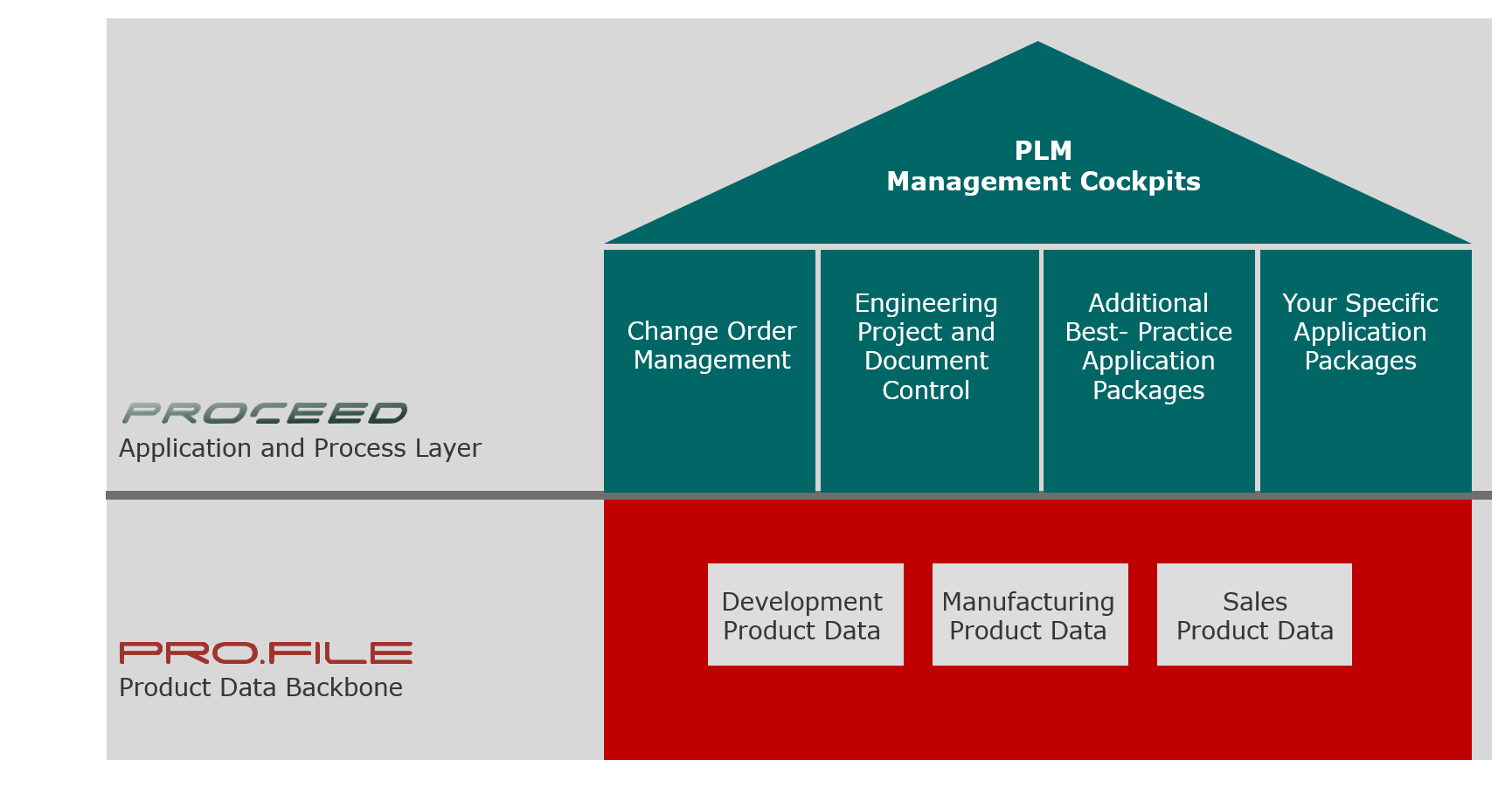
The concept is based on the holistic view that product related information accompanies a product throughout its entire lifecycle. Product data and documents are created from the moment the first specifications are written or an idea is sketched out. More documents are created by the design departments, which are then passed down to production, assembly, maintenance, and commissioning. Quality Control, Contracting, Purchasing, Sales, Customer Support and many other departments all add product related data and documents as the product goes through its lifecycle. As the product is enhanced or changed, this process is repeated cyclically until the product eventually reaches its end of life. Therefore, in order to be effective and efficient, a PLM management strategy needs to lay out how this information is to be made available in order to ensure timely decision making at each stage of the product lifecycle.
An essential role in product engineering and product management
When a company plans, manages, and controls its documents in a single system, it will maximize the efficiency of its projects and processes. This principle is at the core of PRO.FILE’s product lifecycle management (PLM) approach, making PLM software a strategic instrument of the manufacturing sector. It is tightly integrated with a company’s business processes and plays an essential role in product engineering and product management. Manufacturing companies that leverage PLM solutions achieve a faster time to market for their products and reduce costs by creating innovative processes that are transparent and consistent across the enterprise.
The development of new products in the age of digitalization also involves new systems engineering concepts. Today, products need to be more strongly defined by the underlying business model. This requires bridging the gap between development and the respective business departments and business model. This bridge is going to be built by systems engineering as the overriding concept. This is where PLM systems, as a crucial technical tool, come into play.
6.2 CAD, ERP and PLMPLM integrates information from both CAD and ERP systems
Synchronizing item master data, bills of materials, and project data between the design and production department is always a major challenge but it is one that can be overcome with the use of PLM. Manufacturing companies are frequently confronted with their workflows grinding to a halt. This is due to the fact that separate data silos and the manual transfer of IT information from one IT system is a constant source of error. Before you know it, bills of materials are no longer accurate, drawings are outdated, required purchased parts are not communicated to purchasing in time and so on. More often than not, this results in having to go back to the production floor for re-work and sometimes even re-manufacture.
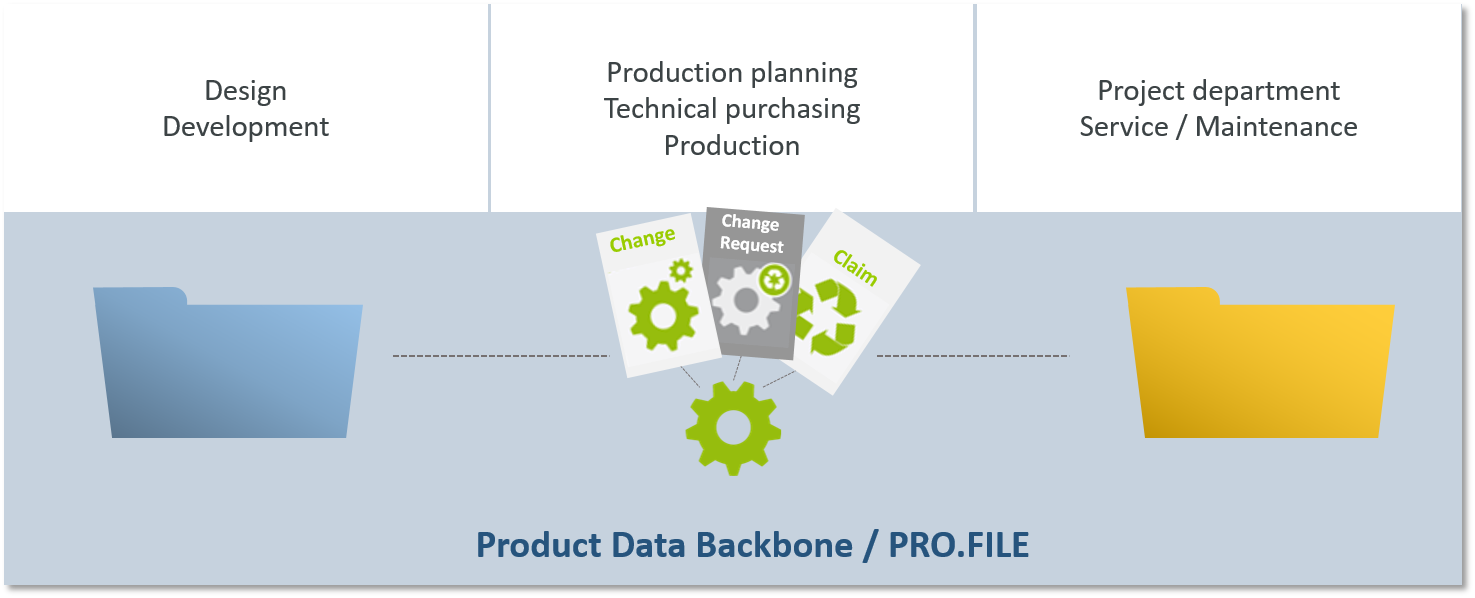
Synchronizing data
Developers and designers are used to working with their CAD systems and storing their data in the PLM system. Production planners, purchasers, material requirements planners, and production staffers maintain their data in an ERP system. The PLM can be leveraged to integrate both environments and synchronize the data. This allows it to integrate information from CAD and ERP systems alike and to synchronize the data from both IT landscapes.
In this, the PLM system takes on two important roles:
- Consolidating the data from multi-CAD environments with mechanical CAD, electrical CAD (e.g. control cabinet construction) and electronic CAD systems. The PLM solution PRO.FILE, for example, then only needs a single interface with the ERP system to transfer all of the development data to the ERP system.
- Synchronizing the part master data created during the design stage with the ERP system in production planning and technical purchasing. This, however, involves more than just exchanging data using Excel spreadsheets or ASCII files, which essentially means relinquishing all control over the data. What it does require is complete process control, visibility, and end-to-end documentation of the exchange process (monitoring).
6.3 Seamless ProcessesGetting out of the digital dead end
A PLM solution creates a seamless experience, giving everyone along the process chain – whether it’s order processing, design, production, or sales – controlled access to a consistent and unified Product Data Backbone. This means that establishing a Product Data Backbone is the key to end-to-end PLM because the rapid pace of Digitalization in product-centric industries is continuously increasing the number of systems across the enterprise where production related information is created and stored. On top of that, data volumes keep growing and are becoming increasingly heterogeneous. These sources of data need to be incorporated into the Product Data Backbone to serve as information sources across the entire PLM process.
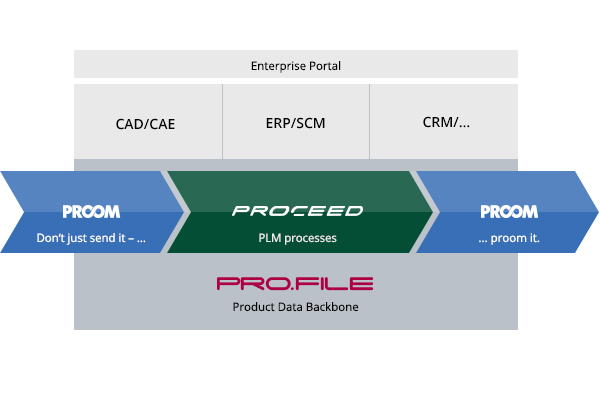
Point solutions for PDM, DMS or CAD data management are no longer sufficient and are a dead end. The way out of this digital dead end is that companies will stop purchasing licenses for point solutions, companies will be increasingly able to choose granular, preconfigured application packages and services from a digital platform that enable them to perform dedicated tasks and quickly add on to them, on demand. PROCAD is developing such a platform and, with PRO.FILE, is giving its customers a scalable solution that moves along the evolutionary path of PLM in the enterprise. As a digital platform, it lets them add a wide variety of services in the fields of drawing management, technical document management, file exchange, change management etc., and to do so on the basis of a common data repository, the Product Data Backbone.
From document management to process control
While PDM and DMS have long become a staple in many companies, the implementation of PLM process and project management as the next step is often dead on arrival. Due to the fact many medium and large manufacturing and engineering companies shy away from having to pay for lengthy consulting projects and want to see results right away.
Improving the efficiency of product lifecycle processes is usually an evolutionary development. Controlling documents based on their status, for example “Document in process” or “Document released”, is the norm in product data or document management systems (PDM system with DMStec). In certain cases, adding task based control mechanisms can have an additional effect.
Whenever manufacturing and engineering companies want to control and automate recurring processes or processes with multiple stakeholders that cut across the company, they should consider working with PLM task files. Everyday, they have to deal with processes that involve large amounts of documents and data which is why tasks, the data to be processed, and documents are combined into a task file. Tasks, in turn, belong to processes or projects whose chronological order is controlled. With this type of advanced flow logic in place, even subtasks can be automated, making the transition from document management to process control complete.
With the PRO.FILE PLM system task files, processes and projects specific to the application at hand (e.g. for Engineering Change Management) can be automated and controlled through a separate add-on. Here, the actual PLM processes are implemented using pre-configured application packages. They consist of templates, out-of-the-box workflows, cockpits, reports and menus to operate the different monitoring and project and process control processes. Best practice application packages are available to help customers implement their specific workflows faster. This means that companies no longer have to take a green field approach to designing their PLM processes. This is particularly helpful for those that want to get started right away and neither have the time nor the money to engage in lengthy consulting and implementation projects.
6.4 Process ControlIT based PLM process control or not?
Overall, employing task management increases the level of process control. This takes away a certain level of freedom, adherence to rules and guidelines is facilitated and promoted. The result is better compliance and process automation.
Particularly in product-centric industries, software driven PLM processes should not be an end in itself. “Cementing” just about everything that can be modeled in software into an IT process, an approach advocated by many process consultants, is often simply not the way to go for mid-sized and larger companies. Companies that go down this path lose a lot of time and money before they even see results, which negates much of the savings they hoped to achieve through automation. The implementation in itself is also critical. The lack of process and change management expertise coupled with the extensive time and resources spent on the implementation only increase the costly dependency on consultants or turn the implementation into a never ending project. The consequence: Many projects are terminated before anyone benefited from it.

Manufacturing and engineering companies need to ask themselves: At what points in the PLM processes does it make sense to model the process in the software and automate it, both from an organizational and business perspective? Should PLM process control be IT based or not? A large number of iterations and users or stringent compliance requirements are a strong indicator. Once you have identified the PLM processes with the highest potential, a more effective approach is to rely on a ready made, IT based best practice process and to compare it to your actual requirements rather than to start out with abstract performance specifications, which will eventually be thrown out anyway because they turned out to be impracticable.
6.5 Application PackagesFrom change management to risk and contract management
Best practices provide a proven path to quickly implement new software applications into practice. You don’t have to start programming from scratch, but rather rely on approaches that have already been successfully tried and tested elsewhere. PROCAD calls this pre-configured application packages. They are PLM scenarios tailored to the needs of customers in product-centric industries that are offered under the product name “PRO.CEED”.
In technical manufacturing environments, these pre-configured best practice application packages provide a great way to drive the evolution of PLM in the enterprise and to enable the end-to-end digitalization of business processes – starting from the simple CAD data management practices of the early days all the way to the digital thread that connects ongoing operations with development and governs the feedback of information in a company’s business processes. Working with these pre-configured packages, that allow them to iteratively and gradually add new IT processes along the way, companies are prevented from falling into the “customization trap” that necessitates extensive software modifications.
These packages give customers a fast and easy way to implement PLM scenarios. They can be requested as part of their software maintenance agreement. Change management, risk management, and contract management are just some examples. What’s more, the toolset also allows for the creation of additional, custom application packages, for example for compliance management, test management, performance management or quality management.
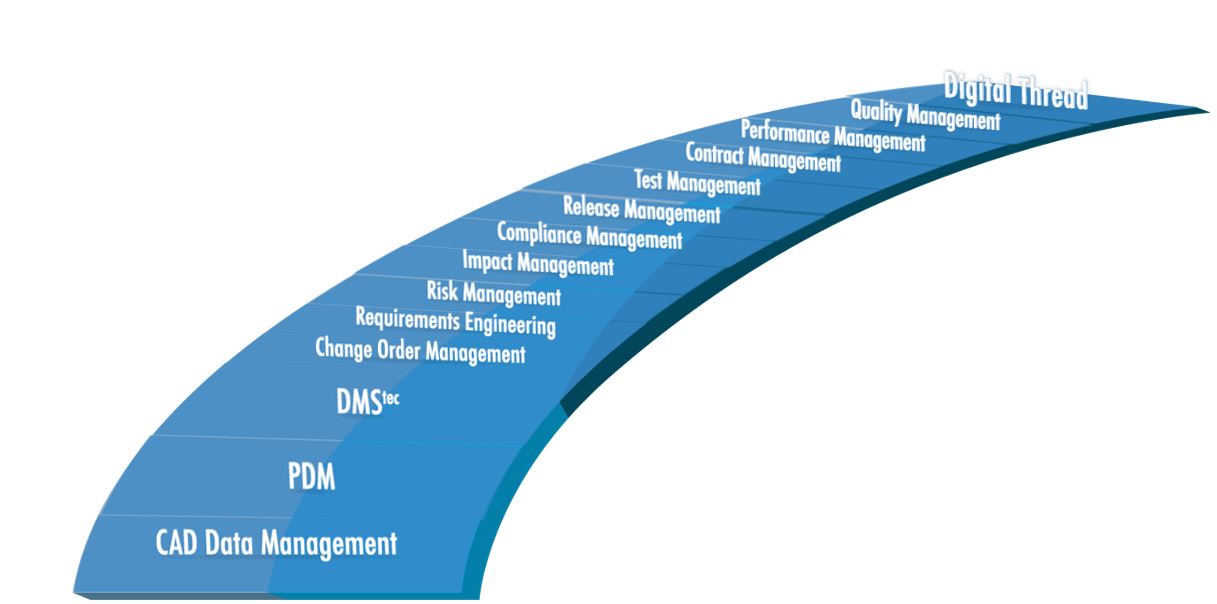
Engineering Change Management – automating processes and monitoring the impact
Development projects frequently require the implementation of short notice changes, which can confound even the most careful calculations and schedules. Attempts to manually coordinate the change order process usually take up too much time. Task files present a solution to this problem. Process control means tying a company’s task management to its product data to enable users to retrieve all data and documents that are relevant to a process or project from a single source. This improves the coordination of ongoing product lifecycle processes or projects, which in turn reduces processing times and avoids errors that occur when processes intertwine, by automating the product lifecycle management (PLM system) processes involved. The system notifies users of any deviations and provides instant visibility into the current change status. Users can choose to automate parts of the change process such as the sending out of documentation or creation of an impact matrix to determine the impact of the change, making it easy to determine the actual cost of a change order.
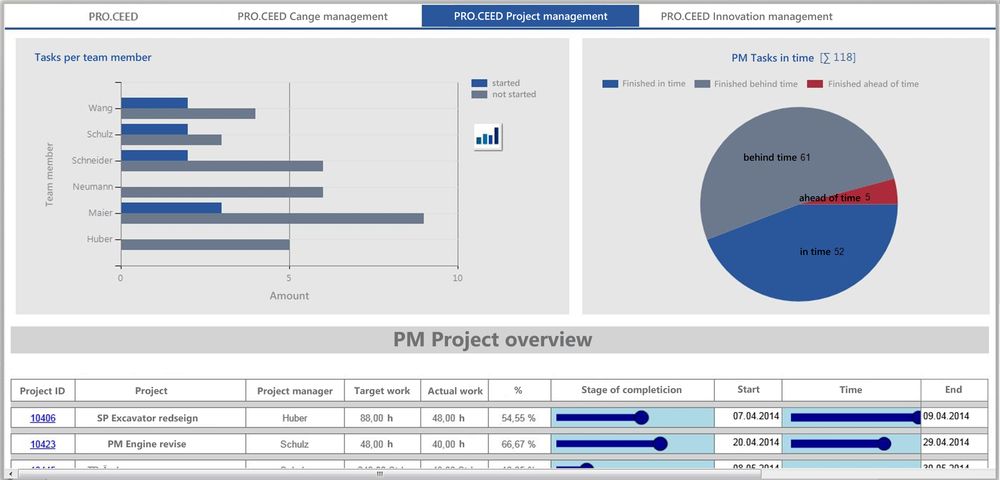
The PLM system serves as a single point of control for managing all product data, documents, tasks and process control information for change management purposes. It comes with a built in escalation model to respond to schedule deviations and a dashboard that allows users to stay on top of the change status at all times.
Risk management – identifying, mitigating, and counteracting risks
Each project, order or contract presents a certain amount of risk for every company. Many risks are interrelated or affect other objects such as contracts, accompanying documents, general terms and conditions, correspondence or collateral agreements. The purpose of risk management is to initiate the appropriate measures to minimize risk and to proactively mitigate future risks.
Over the past years, there has been a sharp increase in regulations that companies need to comply with. A multitude of national laws, international guidelines, and self-regulations require companies to meet strict documentation obligations. Product lifecycle management systems (PDM/PLM systems) can make this a lot easier. PDM/PLM systems that are designed as a DMStec system are ideally suited for this by providing a Product Data Backbone that brings together all data and documents and not just those generated by the design department. Such a solution enables companies to set up a compliant risk management process and integrate it with their PLM process.
The first step is to create a risk file that serves as a central repository for all risk related documents in the PDM/PLM system. Using these documents as a starting point, it becomes possible to identify, assess, and prioritize any resulting risks. They are grouped into risk classes and addressed by planning initial risk mitigation measures. An early warning system provides updates on the progress of these measures and notifies users in the event of escalations. Risks can be identified early on and the company can continuously counteract them.

The PDM/PLM system PRO.FILE comes with a risk cockpit that enables users to group projects and contracts into risk classes using a traffic light system and to assess the effects of countermeasures. By establishing processes controls that provide complete audit trails and having a consistent methodology for the assessment of risks, companies can ensure compliance with all applicable laws, rules and regulations. What’s more, companies can draw from the experience gathered to develop new risk mitigation strategies.
They can, for example, leverage the PDM/PLM software to model complex approval workflows to comply with the authorization procedures of relevant authorities. Companies in the aerospace industry, for example, are required to seek approval from the relevant aviation authority and sometimes other institutions for every modification to a part. They need to document these modifications within the context of their change order management in test plans, maintenance manuals, flight manuals, and other document types and more often than not, each document involves multiple approval processes that need to be completed. The PDM/PLM delivers visibility into the logic behind these processes and allows the company to put them into a risk management context, providing it with detailed audit trails of who created and approved a document under review and when.
Contract management – a bird’s eye view of all contracts with built-in escalation management
A contract establishes the basic principles of a company’s business relationships with customers, suppliers, partners, and other third-parties. Making this information available to the right person, at the right time and place is part of the product lifecycle management process. Having centralized contract management in place is the only way to ensure that deadlines and other contractual obligations are met. A lack of visibility can often lead to these simply being forgotten once the contract is closed.
Contracts are often negotiated and closed individually by the different departments within a company. The consequence is that the management of these contract documents is distributed across the various business units. This practice of distributed (paper) filing, however, results in these documents being hard to trace once they are needed and there is uncertainty as to whether or not different departments may have entered into identical contractual agreements with one and the same vendor. It would be desirable, for example, to provide the purchasing department with an easy means to find out how many contracts exactly were closed with which companies, to compare the conditions of these contracts, and to assess where there may be opportunities to consolidate and harmonize contractual relationships in order to get better conditions.
After all, it is rather common that a contract is not terminated in time because the relevant documents were nowhere to be found to check the deadline. Many companies end up spending too much money on contracts that were inadvertently renewed due to poor deadline management.
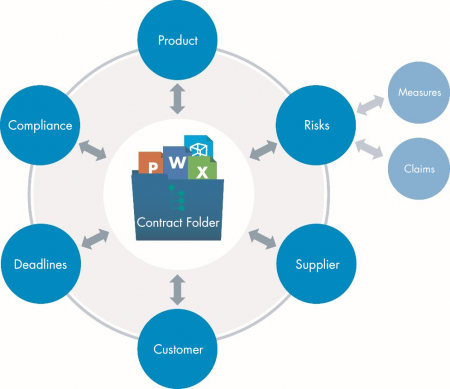
The PDM/PLM system gives companies a central repository to digitally manage all of its contract files that relate to a specific order, project, or product along with any accompanying documents. It delivers a feature rich contract management system that provides users with complete visibility into the contents of their company’s contracts. The system has a built in escalation management process that automatically sends out timely contract reminders before deadlines expire, preventing users from missing cancellation deadlines ever again. This eliminates the need to maintain this information in paper form or in Excel spreadsheets as the processes for enterprise wide contract management are automated.
The product lifecycle management (PLM system) system also provides users with text modules and templates that allow them to draft contracts faster. Contract management guides them through the entire process, from contract preparation through closing. This reduces processing times and allows everyone to get instant overviews of a contract’s current location and status. Granular permissions ensure that contract documents can be accessed by authorized users only.

